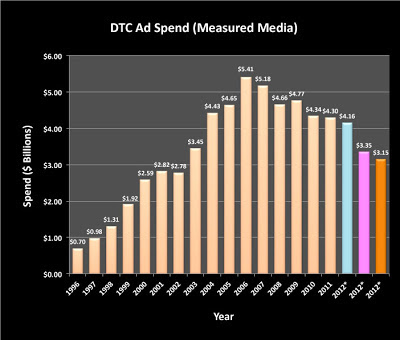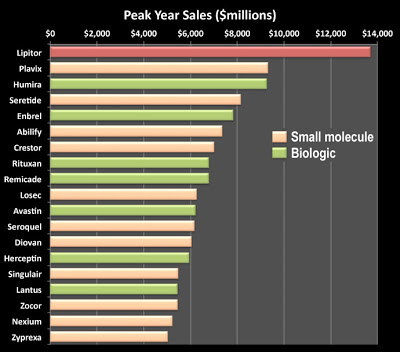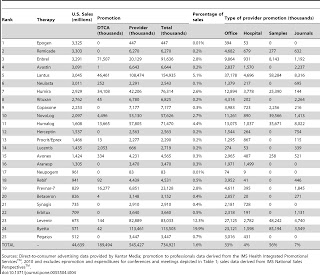By now you should be familiar with charts like the following, which documents the decline in direct-to-consumer advertising (DTCA). [Please read “Pharma DTC Ad Spending Took a Nosedive in 2012!” for details regarding the last 3 bars of the chart.]
What are the causes of this decline?
As many experts have pointed out, there are several likely causes, including the recession of 2007-2008 (see here), shrinking pipeline (fewer new drugs means fewer ads), and the rise of generics (which are not advertised).
But have you noticed that the sales of biologics have taken off? And that means there is less need for the type of DTCA that pharma has traditionally relied upon; i.e., BROADCAST DTCA (TV and print). Could this be a factor in the most recent 22-26% drop in DTC spending (2012 compared to 2011)?
Forbes published a list of “Best Selling Drugs of All Time” (see here). I created the following chart from the data cited (click on it for a larger view):
Many of these are biologics. But many biologics have not yet reached the all-time sales records of DTC-advertised pills. Given time, we are likely to see an even higher proportion of biologics on this list.
Here is a table of the top US-selling biologics (in 2010) along with product-specific expenditures and promotional spending toward consumers and providers (taken from PLOS research article: “Promotion of Prescription Drugs to Consumers and Providers, 2001–2010“).
Although these are 2010 data, we can see that relatively little was spent on DTC advertising for these 25 top selling biologics — a total of $185.5 million compared to $4,371 million for total 2010 DTC spending, according to data from this source.
“Declining promotion may also reflect the increasing biologics share of the market,” suggest the authors of the PLOS study cited above. “Declines in DTCA may accelerate as biologics make up a greater share of new therapies. Biologics often have unique routes of delivery and storage and can be very costly compared to small molecules, with costs for one cancer drug, Avastin, exceeding $100,000 per year. Given that use of new biologics is concentrated among a smaller number of patients with relatively rare conditions treated primarily by specialists, we would expect promotion to providers and consumers to also be highly targeted.”
What’s the best medium for “targeted” advertising? The Internet. Duh! However, as the authors note, “Although relative increases in DTCA through media such as the Internet and social networking have occurred, these expenditures remain a small fraction of overall consumer-targeted promotion.” From the authors’ data, I calculate that Internet DTC spending in 2010 (not including search advertising) represented only 4.6% of the total DTC spend for that year.
What about 2011 and 2012? Has the percent of Internet spending versus total DTC spending increased significantly? I have some data from 2011 that suggests this percent was 4.7% – no increase (see pie chart below).
So, pharma marketers either don’t have to do much DTC marketing of any sort to sell biologics or they haven’t figured out how to use the Internet to do targeted marketing of biologics to consumers.












![6 Digital Tools at the Center of Healthcare Digitalization [INFOGRAPHIC]](http://ec2-54-175-84-28.compute-1.amazonaws.com/pharma-mkting.com/wp-content/uploads/2021/04/6DigitalTools_600px-100x70.jpg)




